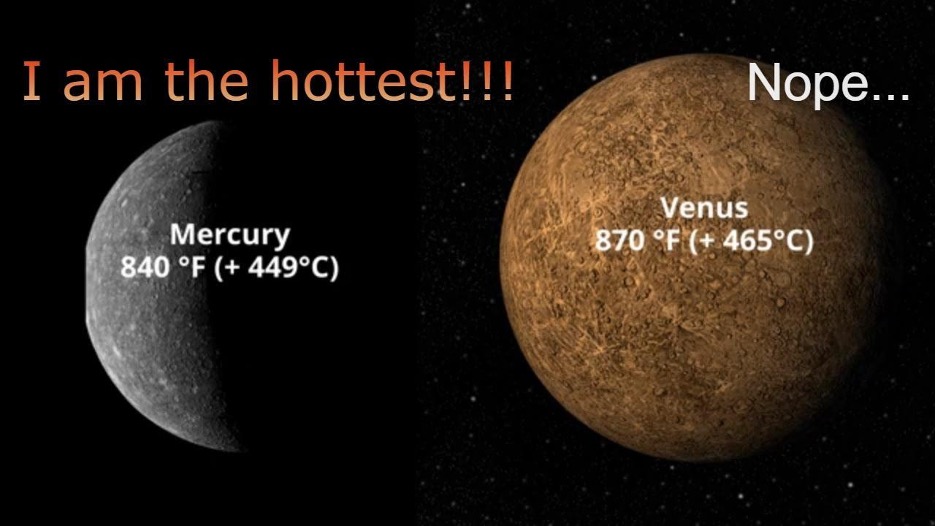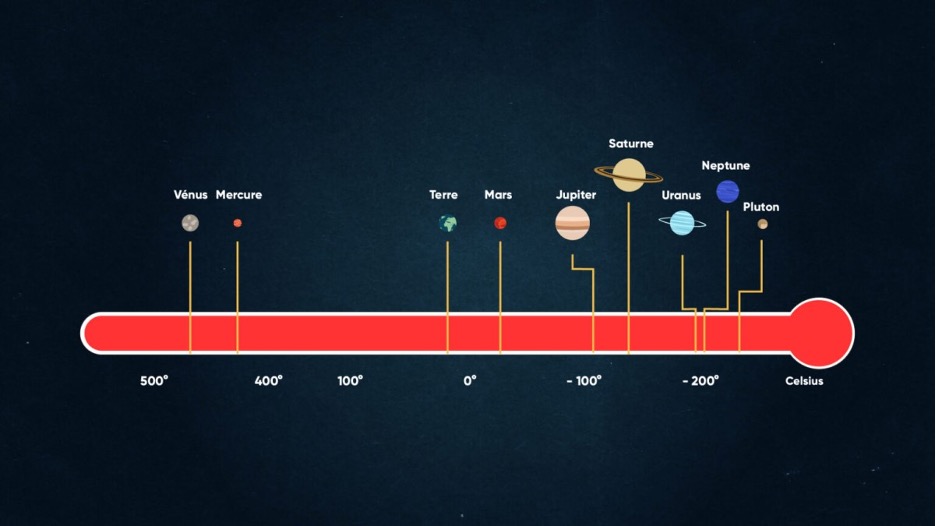Venus or Mercury: What is the hottest planet in the Solar system?
16th Dec 2022
If you have ever sat by a bonfire, you have noticed that the closer you are to the flame, the hotter you get. Our solar system can be described very similarly, where the Sun acts as the big fire, and the planets are located around it at different distances. They absorb the energy of the Sun and radiate it back into space. Also, the side facing the Sun heats up more, which is why it is usually warmer during the day than at night.
If proximity to the Sun were the only factor determining the planets’ temperatures, then Mercury would inevitably be the hottest, and the rest of the planets would get ever-colder with distance. But this is not the case with our solar system. Venus’s temperature is higher than the temperature of Mercury even though it is the second planet from the Sun. Surprised? Well, let us find out why Venus is hotter than Mercury and what is the hottest planet in the solar system.
How hot is Mercury
Mercury is indeed very hot because of its proximity to the Sun, but its temperature is not even. During the day, the heat is really terrible: the surface heats up to 430 °C, the temperature at which tin, lead, and zinc melt. But at night it is very cold: up to minus 183 °C! But this temperature range applies only to areas near the equator. It is always cold at the poles, around -90 °C. Why is that?
From sunrise to sunset, a whole Mercury year passes, or three Earth months, which is exactly how much Mercury needs to make one orbit around the Sun. And that’s how long the night lasts, too. It is no wonder that during the day, Mercury’s surface has time to heat up, and at night, it cools down considerably.
Such sharp temperature changes are also facilitated by a very rarefied atmosphere, a loose surface that does not conduct heat well, and a highly elongated orbit. At the far point (aphelion), Mercury is one and a half times farther from the Sun than at the near one (perihelion). Because of this resonance, Mercury always turns to the Sun with the same side at perihelion; or more specifically, with two meridians on opposite sides of the planet, in turn. These meridians are called “hot longitudes,” where the temperature of Mercury is highest. But it is always cold at the poles because, due to the very small axial tilt of the planet, sunlight hardly reaches these areas.
How hot is Venus
Venus is about twice as far from the Sun as Mercury and rotates even slower. It takes 225 Earth days to complete one revolution around the Sun, half of which is in sunlight and half in darkness. But if you want to know how hot Venus is, you’ll be in for a surprise: the average temperature of Venus is 462°C, at any time of day or night! In other words, even a deep Venusian night is hotter than the hottest Mercurian noon! Let’s try to explain this strange phenomenon.
Why is Venus hotter than Mercury?
As you remember, Venus is located almost twice as far from the Sun, which should be of great importance from a logical perspective. As sunlight spreads through space, a more distant object will receive less of it. This is where Mercury, which receives almost four times more solar energy per square metre than Venus, has the advantage. In addition, Mercury has a lower albedo (the light-reflecting ability of objects) of 0.119 versus 0.9 for Venus, which means it absorbs almost nine times more sunlight than Venus! And yet, despite all this, the temperature on Venus is higher than on Mercury, which means that there is an even more important parameter defining planet temperature.
The thing is, objects have the ability not only to absorb energy, but also to give it away. Mercury is closer to the Sun, but due to the fact that it has practically no atmosphere and all the heat that it receives, it immediately gives back into space. Venus, on the contrary, has a very dense atmosphere with a high content of carbon dioxide, which creates a greenhouse effect on the surface and prevents heat from escaping. Think about people around the fire again, and imagine that the person who sits further (Venus) is wrapped in a blanket. Both people receive heat from the fire, but the person in the blanket retains all the heat they receive, even at a greater distance. The dense atmosphere of Venus is this blanket.
In more scientific terms, Venus is shrouded in a thick layer of sulphuric acid clouds 20+ km thick, which trap the vast majority of radiated heat and distribute it across the planet at speeds of 210 to 370 km/h. That is, Venus is constantly “pumped up” with thermal energy, turning it into a huge greenhouse, the self-heating reaction which can no longer be stopped.
This clearly answers the question of why would the surface temperature of Venus is higher than Mercury, even though Mercury is closer to the Sun.
What is the hottest planet in the solar system?
Today, this title belongs entirely to Venus. Mercury holds the second spot, and Earth is the third. Yes, indeed. The average temperature on our planet is 7 degrees Celsius, and that is why it is the only suitable planet for life. And the coldest planet in the solar system is Uranus. The lowest temperature recorded on it is -224.2 °C. At the same time, Uranus is 1.7 billion kilometres closer to the Sun than Neptune, the most distant planet in the solar system. And this once again proves that being closer to the Sun does not necessarily mean being warmer.

But Venus has not always been the hottest planet in the solar system. Scientists believe that about 4 billion years ago, its atmosphere was similar to that of Earth, and there were water bodies on the surface. The unstoppable greenhouse effect was likely caused by the evaporation of surface water and the consequent rise in greenhouse gases.
So, Venus temperature is a clear example of what awaits the Earth if we do not respond to the growing problem of climate change. In the last 100 years alone, the temperature on Earth has increased by 1.5 degrees, and the process of global warming continues. If we do not want to suffer the same fate as Venus, humanity must take this as a lesson and find the right path for future development.





Thank you for your comment! It will be visible on the site after moderation.